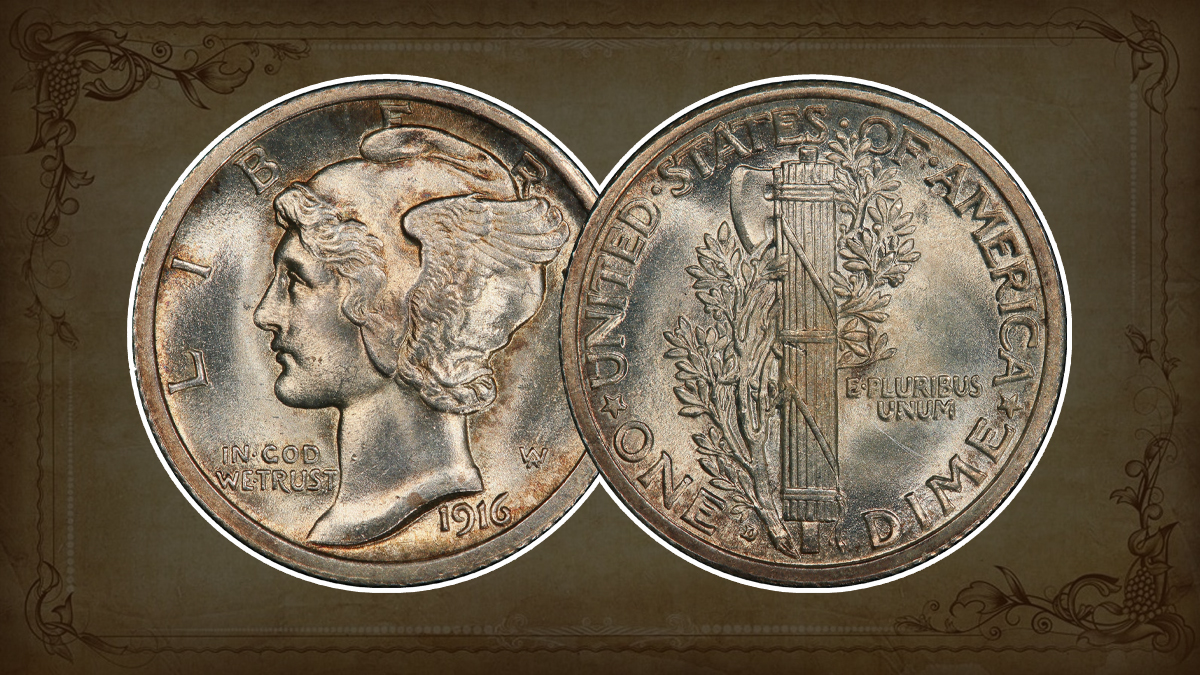
The Mercury or Winged Liberty dime (1916-1945) is an iconic coin in the U.S. series, known for its elegant design influenced by the French Beaux Arts movement of the late 19th century. It was the last U.S. dime to be struck entirely in .900 silver, preceding the Roosevelt dime (1946-Present).
History Of 1916 Mercury Dime
Americans were introduced in 1916 to three iconic U.S. coin designs: the Mercury dime, the Walking Liberty half dollar (also designed by Adolph Weinman), and the Standing Liberty quarter (designed by Hermon Atkins MacNeil). These coins were introduced to the collection of Saint-Gauden’s $10 and $20 gold coins, the Indian Head (Buffalo) nickel, the Lincoln cent, and the Indian quarter eagle and half eagle by Bela Lyon Pratt. This period is often considered a golden age of U.S. coin design.
The Mercury dime entered circulation at the end of October 1916 and remained in production for nearly 30 years. It was celebrated for its beauty and practicality, enduring through World Wars and the Great Depression. The Mercury Dime also became associated with the March of Dimes anti-polio campaign.
The coin’s use continued without significant issues, unlike the Buffalo nickel or the Walking Liberty half dollar. Collectors often seek perfectly struck examples with Full Split Bands on the reverse, which are scarce for some issues. The Mercury dime ended its run when President Franklin Delano Roosevelt died in 1945, leading to a movement to honor him on a circulating coin. The dime was chosen due to Roosevelt’s battle with polio and his work with the March of Dimes.
By the mid-to-late 1960s, silver coins were phased out, and many original Mercury dimes were melted in the silver run-up of the early 1980s. While there are conditional rarities, the series is known for two key dates: the 1916-D and the scarce 1942/1941 overdate.
Specifications
- Country: United States of America
- Year of Issue: 1916
- Denomination: 10 cents (USD)
- Mint Mark: None (Philadelphia)
- Mintage: 22,180,080
- Alloy: .900 Fine Silver
- Weight: 2.5 g
- Diameter: 17.9 mm
- Thickness: 0.053″ (1.35mm)
- Edge: Reeded
- Obverse Designer: Adolph A. Weinman
- Reverse Designer: Adolph A. Weinman
- Quality: Uncirculated
Design
Obverse:
Adolph A. Weinman’s design features Liberty (of Thought) facing left. A winged cap adorns her head, with tufts of hair curling around the base of the Phrygian cap on her forehead and behind her ear. A braid of hair wraps around the base of her neck. “LIBERTY” wraps around the top of the coin with spaced letters, partially obstructed by Liberty’s cap. Weinman’s monogram (a W surmounting an A) appears behind Liberty’s neck. The date “1916” is below the bust truncation.
Reverse:
The reverse features fasces, a bundle of rods bound with leather around a central axe, with the blade facing left. An olive branch wraps behind the fasces. The legend “UNITED · STATES · OF · AMERICA” wraps around the top, and “ONE DIME” at the bottom. Two five-pointed stars split the legend from the denomination. The motto “E PLURIBUS UNUM” appears to the right of the fasces.
Rarity and Condition
In 1916, the Mercury dime was produced at three mints. The Philadelphia Mint struck 22,180,080 coins, the San Francisco Mint struck 10,450,000, and the Denver Mint struck only 264,000 pieces. The 1916-P and 1916-S Mercury dimes are common in all grades, while the 1916-D is much scarcer.
Value Of 1916 Mercury Dime:
Top-graded examples of the 1916 Mercury dime, such as those graded MS68 Full Bands by PCGS and NGC, can fetch significant prices. For instance, a richly toned 1916 Mercury dime in MS68 was sold for $14,687.50 at Legend Rare Coin Auctions in 2018. Other examples have sold for prices ranging from a few thousand to over ten thousand dollars depending on their condition and toning.
Certified examples in grades MS63 to MS65 typically range from $70 to $90, while circulated examples are valued slightly above their intrinsic silver value. It’s advisable to avoid buying raw uncirculated coins unless you can distinguish original surfaces from those that have been cleaned or altered.
Market Data and Noteworthy Specimens
Several high-grade 1916 Mercury dimes have fetched impressive prices at auctions. For instance:
- PCGS MS68+FB CAC #39478604 was sold by Stack’s Bowers in August 2020 for $20,400.
- NGC MS68FB #1600523-002 was sold by Heritage Auctions in January 2024 for $3,249.60.
- PCGS MS68FB CAC #35734616 was sold by Legend Rare Coin Auctions in September 2019 for $14,687.50.
Also Read – 1874 Liberty Seated Dime: A Complete Guide
The Bottom Line
The 1916 Mercury dime is a precious piece of American numismatic history, celebrated for its elegant design and historical significance. While common in lower grades, high-grade specimens can command significant prices. Collectors treasure these dimes not only for their beauty but also for their place in the rich tapestry of U.S. coinage.
